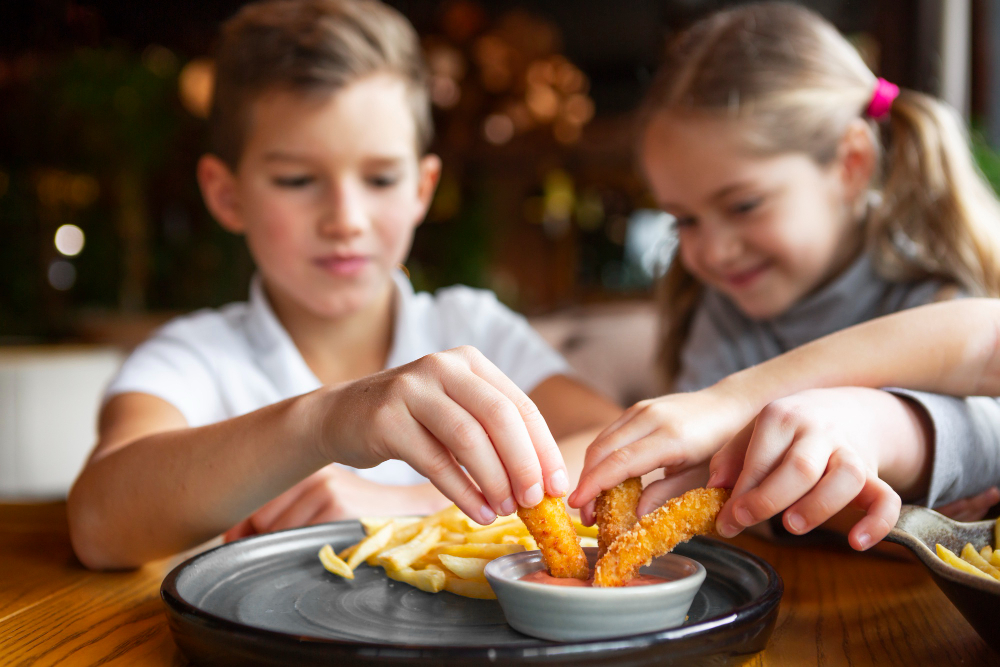How to Handle Picky Eaters: A Parent’s Guide to Stress-Free Mealtime
If you have a picky eater at home, you’re not alone. Many parents struggle with mealtime battles, trying to get their child to eat a variety of nutritious foods. It can be frustrating, but with patience and a few strategic approaches, you can make mealtimes more enjoyable and less stressful. Here are some evidence-based tips to help your child develop a healthier relationship with food.
1. Avoid Mealtime Pressure
Pressuring children to eat or finish their plate can backfire and lead to long-term negative eating behaviors (Satter, 2000). Instead, create a low-pressure environment by letting children decide how much they want to eat from the options provided.

2. Offer a Variety of Foods
Repeated exposure to new foods without pressure increases the chances that children will try them over time (Carruth & Skinner, 2000). Introducing different textures, colors, and flavors in a fun and engaging way can help reduce resistance.

3. Make Meals Fun and Interactive
Turning meals into a playful, engaging experience can encourage children to participate more willingly. Strategies such as cutting food into fun shapes, creating colorful plates, and letting kids build their own meals have shown positive effects (Nekitsing et al., 2018).

4. Get Kids Involved in Meal Prep
Involving children in cooking and food preparation can boost their willingness to try new foods. When kids help in the kitchen, they develop a sense of ownership and curiosity about food (van der Horst et al., 2014).

5. Set a Good Example
Children are more likely to eat a variety of foods if they see parents modeling those behaviors. Parents’ own food preferences and eating patterns significantly influence their children’s diets (Scaglioni et al., 2018).

6. Stick to a Routine
Establishing regular meal and snack times provides structure and helps regulate appetite. Frequent grazing can reduce hunger at mealtime and contribute to picky eating habits (American Academy of Pediatrics [AAP], 2019).

7. Respect Their Appetite (or Lack of It)
Appetites can fluctuate from day to day, especially in young children. Avoid using food as a reward or punishment, as this may lead to emotional eating or disordered eating patterns later in life (Satter, 2000).

8. Offer Dips and Sauces
Familiar dips such as yogurt, hummus, or mild sauces can make new foods more appealing. This tactic can ease the transition to new tastes and textures (Nekitsing et al., 2018).

9. Keep Trying!
Research suggests it can take 10–15 exposures before a child accepts a new food (Carruth & Skinner, 2000). Patience is key—continue to offer a variety of foods without pressure.

10. Seek Professional Advice if Needed
If picky eating is impacting your child’s growth, energy, or daily functioning, consult a pediatrician or registered dietitian. They can help rule out underlying issues and provide tailored guidance (AAP, 2019).

Final Thoughts
Picky eating is a common developmental phase and doesn’t have to turn mealtimes into a daily struggle. By creating a positive, pressure-free environment and making food fun, you can support your child in developing a healthy and adventurous attitude toward eating. Remember—patience and consistency go a long way.
References
American Academy of Pediatrics. (2019). Nutrition: Healthy eating habits for your child. https://www.healthychildren.org/English/healthy-living/nutrition/Pages/Healthy-Eating-Habits-for-Your-Child.aspx
Carruth, B. R., & Skinner, J. D. (2000). Revisiting the picky eater phenomenon: Neophobic behaviors of young children. Journal of the American College of Nutrition, 19(6), 771–780. https://doi.org/10.1080/07315724.2000.10718939
Nekitsing, C., Hetherington, M. M., & Blundell-Birtill, P. (2018). Developing healthy food preferences in preschool children through taste exposure, sensory learning, and nutrition education. Current Obesity Reports, 7(1), 60–67. https://doi.org/10.1007/s13679-018-0293-8
Satter, E. (2000). Child of mine: Feeding with love and good sense (2nd ed.). Bull Publishing Company.
Scaglioni, S., De Cosmi, V., Ciappolino, V., Parazzini, F., Brambilla, P., & Agostoni, C. (2018). Factors influencing children’s eating behaviours. Nutrients, 10(6), 706. https://doi.org/10.3390/nu10060706
van der Horst, K., Ferrage, A., & Rytz, A. (2014). Involving children in meal preparation. Appetite, 79, 18–24. https://doi.org/10.1016/j.appet.2014.03.030




